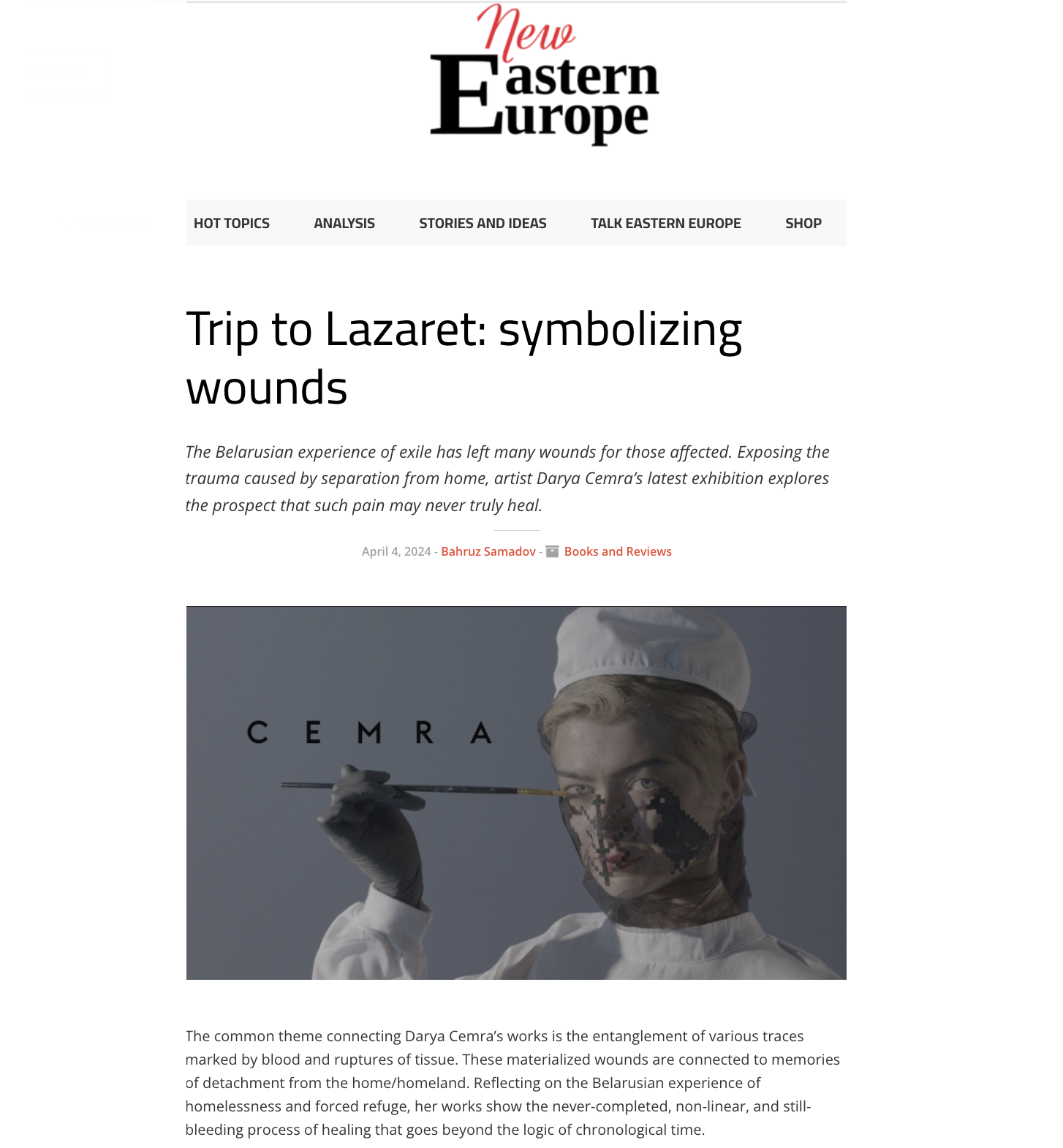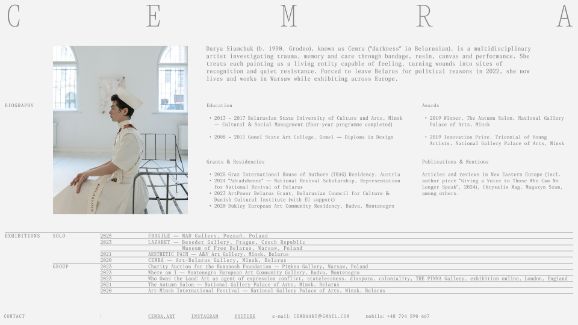

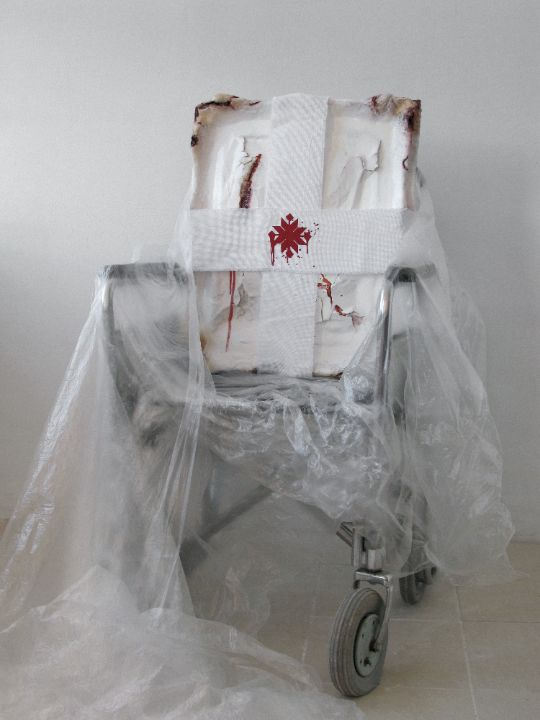
painting (object), mixed media on plaster-bandage form: oil, acrylic, polymer coating, fabric, embroidery; wheelchair (support)
120 × 70 × 90 cm, 2025
B Rh+
oil on canvas, 86 × 69 cm, 2024
Political Prisoner Painting
As of November 20, 2024, nearly 1,300 people in Belarus have been officially recognized as political prisoners, and human rights activists have documented over 7,000 individuals involved in politically motivated criminal cases — 6,113 of whom have already been convicted. It is clear that these numbers do not encompass all those subjected to political persecution in Belarus in recent years.
In Belarus, political prisoners are often subjected to not only physical but also psychological torture. One form of such repressive practice involves special tags used to mark political prisoners. These tags signify the prisoners’ “special status,” making them even more vulnerable within the penitentiary system. Political prisoners marked with these tags are automatically subjected to heightened surveillance, harsher detention conditions, and additional pressure from prison authorities.
Former political prisoner Viktor Parkhimchyk, who fled Belarus for Poland in November 2022, managed to secretly bring with him the prison uniform he wore during his detention. Viktor now wants the world to see it. The international community must recognize the scale of repression in Belarus, and every detail, including these tags, helps to reveal the extent of violence in Belarusian prisons.
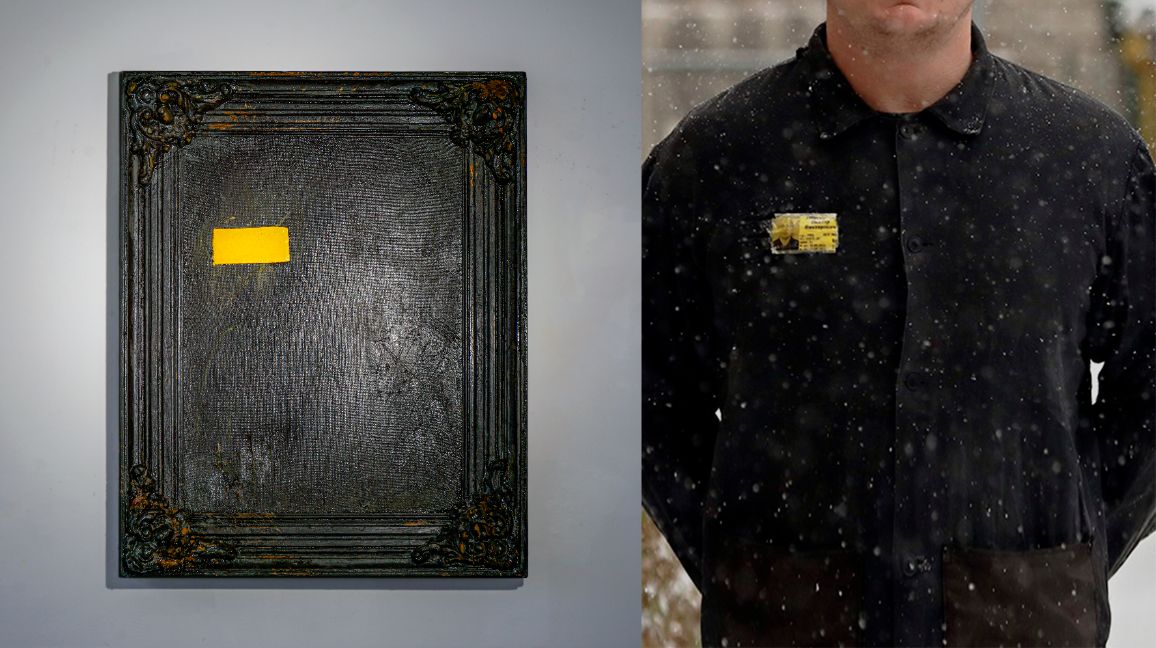
plaster bandage form, pastel, oil, resin coating, 66 x 50 cm, 2024
Spleen
This work is dedicated to my removed spleen — a silent organ with a loud cultural echo. In English and French literary traditions, “spleen” became synonymous with melancholy, ennui, and existential fatigue. To be “a man without a spleen” once meant to be cured of illusion, anchored in reality. But what does it mean to carry its absence in the body?
Here, the scar becomes both wound and witness — a visible trace of an invisible transformation. It marks not just a loss, but a shift: from fragility to resilience, from silence to form. The body, interrupted, begins to speak.
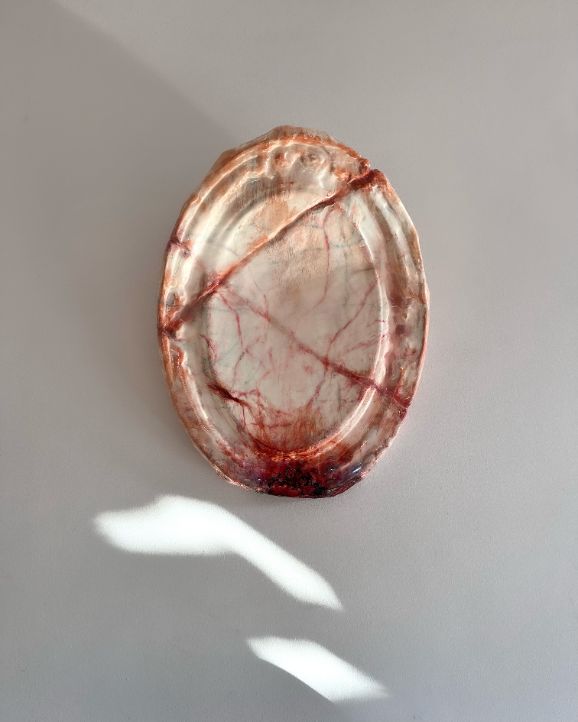
mixed media on canvas, 96 × 76 cm, 2025
Lack
The smooth surface is an illusion of a coherent self. The rupture is an intrusion of the Real—what resists description and upsets order. Yet it is precisely through this fissure that new energy emerges: the possibility of transformation.
Lack is not a depiction of breakage; it is a gesture that shows how a crack can be a beginning. What is missing shapes us more powerfully than what is present. You are not what you have, but what you lack.

hard plastic in wooden frame, 90 × 65 cm, 2024
Purge / Ačystka / Təmizləmə
The person to whom this work was originally dedicated — Bahruz Samadov — has been accused of harassment, sexual abuse, and acts of violence against women. At the time of the dedication, I was unaware of these crimes.
Such violence is intolerable, and the perpetrator must be held fully accountable for their actions.
The painting “Purge” explores the universality of the experience of political repression, highlighting how mechanisms of oppression operate regardless of where they take place. Based on the story of an Azerbaijani scholar unjustly accused of treason, this work brings to the forefront not only his personal struggle but also similar tragedies occurring in Belarus, Azerbaijan, and other countries where authoritarian regimes suppress freedom of thought and expression.
This work calls for solidarity, reminding us that borders do not divide us when it comes to fundamental values: freedom, dignity, and the right to justice. Repression in one country serves as a warning to another. Through “Purge,” I aim to show that unity is possible even where everything seems broken. Art becomes a space where the pain of one individual finds the voice of many, and a local tragedy is revealed as part of a global experience. Only through mutual understanding and solidarity can we create a space for resistance against injustice, where memory and attention become a form of struggle for shared freedom.
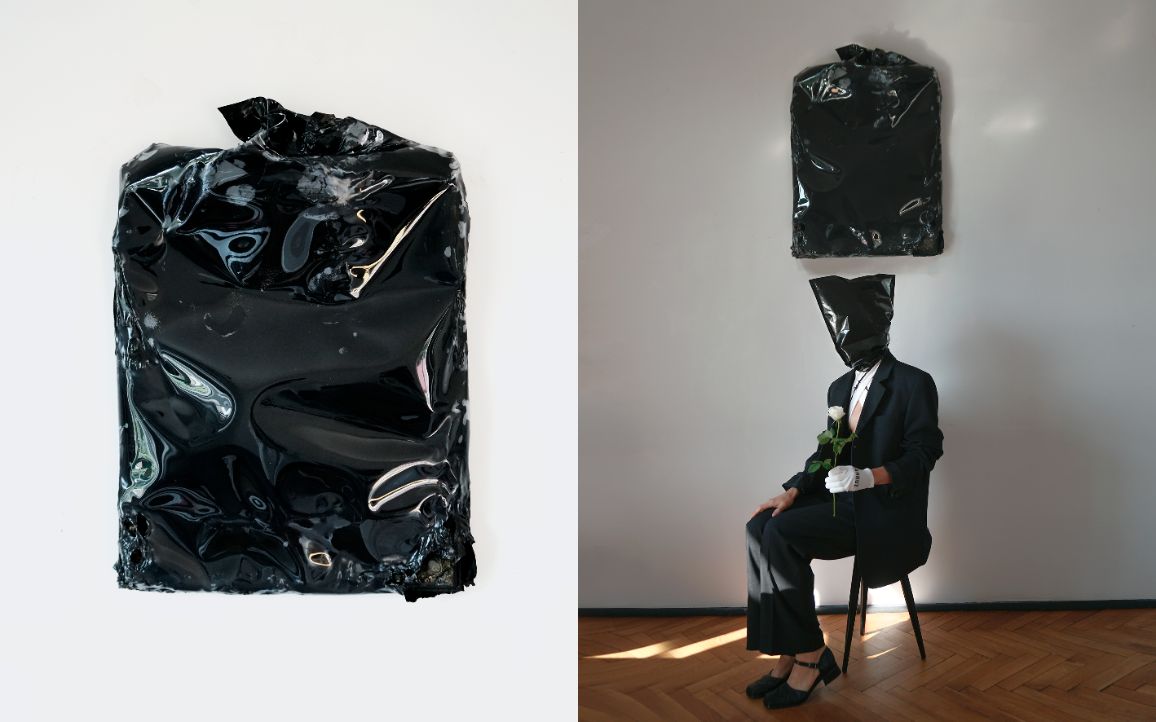
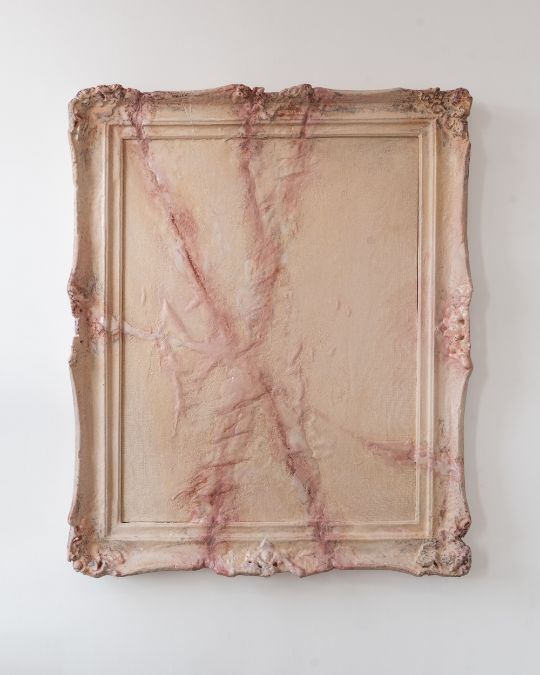
oil on canvas, 120 × 100 cm, 2025
The Consequences of Love

plaster bandage form, pastel, oil, resin coating, 122 × 102 cm, 2024
Amputation of Roots
The severed part becomes a symbol of what can no longer be integrated into the present — a painful yet necessary break from the past. But the wound is not only absence; it is also a beginning. In the space of removal, a more complex and shifting identity can emerge.
Amputation becomes an act of resistance and survival — a testimony to the pressure of systems that demand silence, and to the resilience of those who persist.
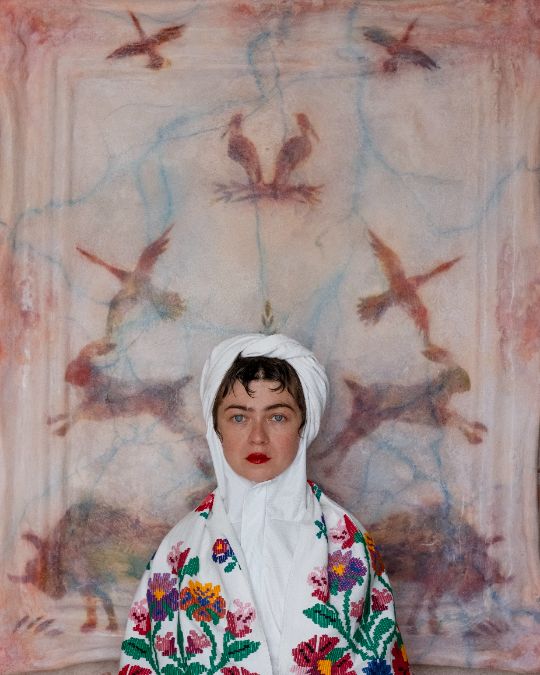
plaster bandage form, pastel, resin coating, 122 × 102 cm, 2024
Vycinanka (ad slova cisk)
In this work the delicate ornamental language of vycinanka, rooted in folk ritual, is reimagined as bruises on the body. Decoration becomes an archive of pain: the blue discolouration left by pressure serves as a visible trace of historical violence. The picture plane operates as a living skin, where ornamental beauty lays bare experiences of political oppression and loss.
Belarusian vycinanka has been inscribed on the UNESCO List of Intangible Cultural Heritage.
plaster bandage form, pastel, oil, resin coating, 66 x 50 cm, 2024
Spleen
This work is dedicated to my removed spleen — a silent organ with a loud cultural echo. In English and French literary traditions, “spleen” became synonymous with melancholy, ennui, and existential fatigue. To be “a man without a spleen” once meant to be cured of illusion, anchored in reality. But what does it mean to carry its absence in the body?
Here, the scar becomes both wound and witness — a visible trace of an invisible transformation. It marks not just a loss, but a shift: from fragility to resilience, from silence to form. The body, interrupted, begins to speak.

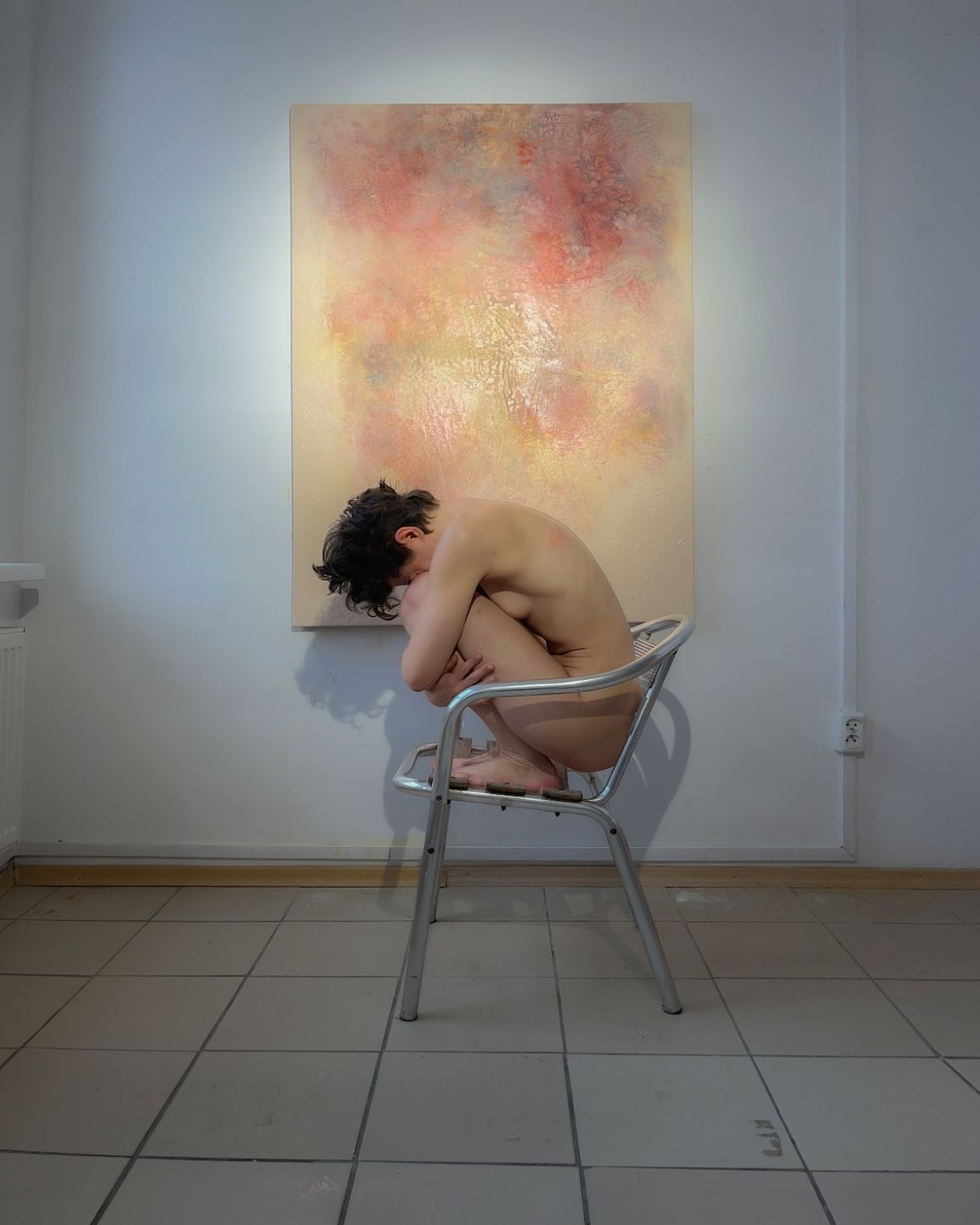
plaster bandage form, oil, resin coating, 88 × 70 cm, 2024
Purity
A pristine, shimmering painting that mimics the surface of porcelain. It captures the eye with its unusual central element — a human navel. This element symbolizes a profound reflection on the purity and intimacy of human nature. To be pure is not about striving for a sterile ideal but about recognizing that our wounds, vulnerabilities, and joys are an integral part of this profound purity.
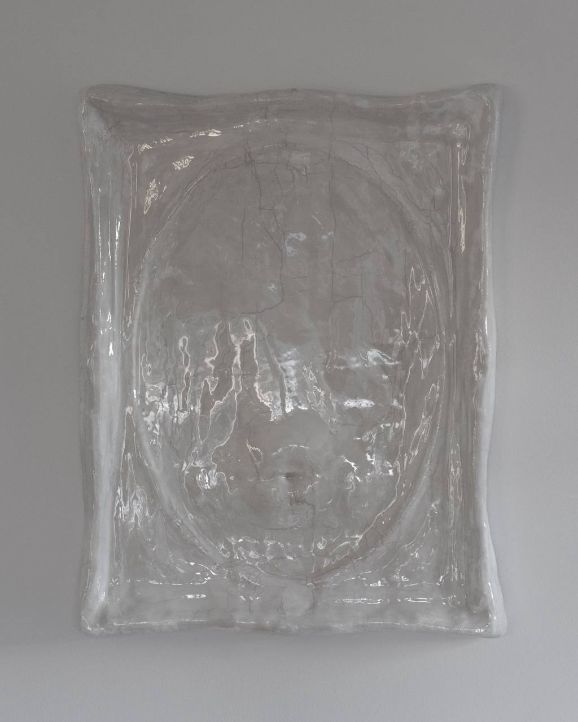
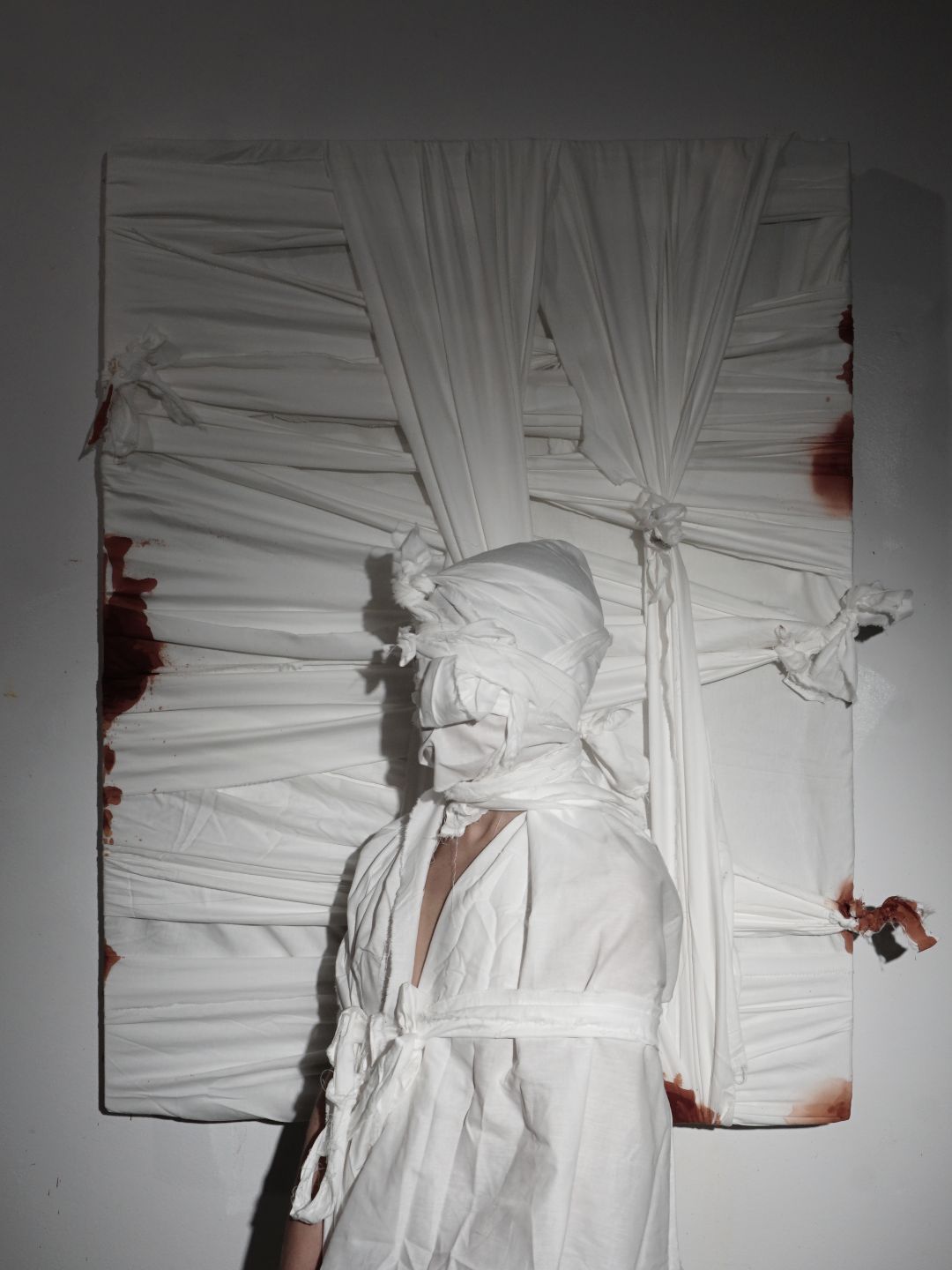
oil on fabric, framed canvas, 113 × 85 cm, 2024
Cocoon
I interpret “cocoon” as a metaphor for inner struggle, recovery, or evolution. It prompts reflections on freedom, pain, and the process of transformation.
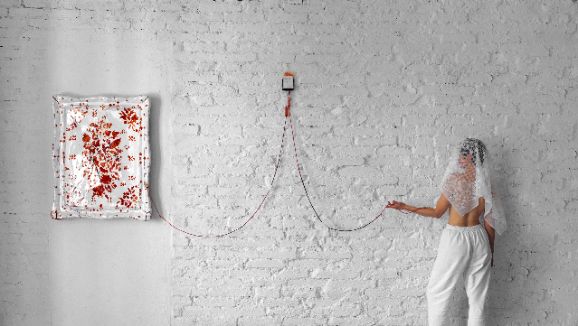

mixed media on canvas, 60 × 50 cm, 2024
Touch
This work explores the delicate boundary between intrusion and transformation. The painting reflects the process of encountering our wholeness and the one who disrupts it. It is an invitation to reflect on how we respond to those who touch us too deeply and how such interactions shape our own identity.
This touch can leave a mark that changes us forever — like a crack through which light enters, or a wound that takes time to heal. Such moments are not merely encounters with another person but also meetings with ourselves. They dismantle the familiar structure of our “self,” compelling us to rethink who we are.
Canvas, wood, fire, oil, resin coating, 110 × 80 cm, 2024
Inventory Number
The burned surface of the painting and the inventory number serve as a metaphor for the attempt to comprehend the structure of meaning and to divide the world into “understandable” categories.
This work is a call to reflect on the nature of control and freedom, and on how easily numbers can lose their connection to real people and their stories. The “inventory number” stands as a testament to lost hopes and freedoms, but it also serves as a reminder that each of us has the right to ask questions, to seek answers, and to fight for our own story.

mixed media (cement and silicone), 96 × 76 cm, 2024
Sensitivity
The contrasting colors — cool gray and warm pink — highlight the complexity of emotional states. Gray conveys resilience and pressure, while pink evokes openness and life. Their combination creates visual tension, inviting contemplation of how external strength and internal sensitivity shape our essence, and how new strength and wholeness arise from apparent fragility.
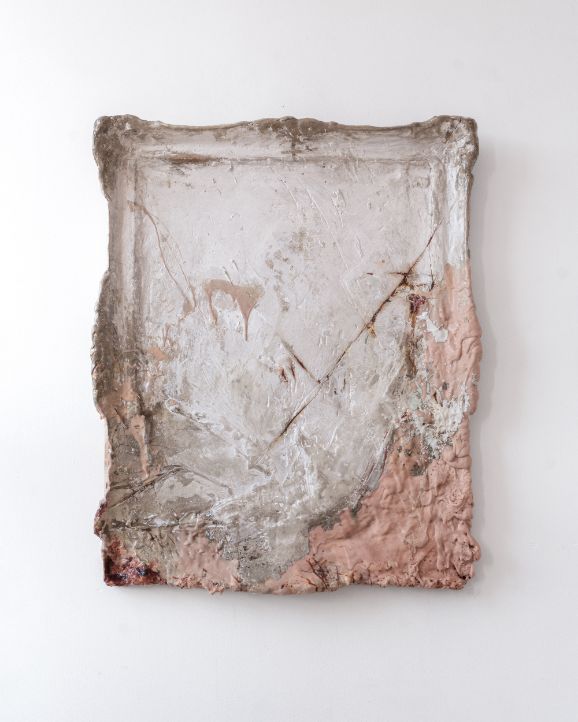
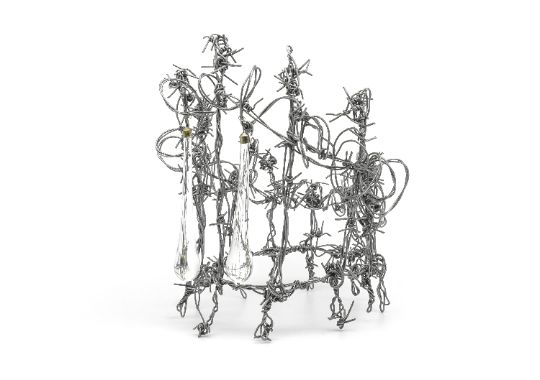
barbed-wire crown with two suspended glass tears, 25 × 23 cm, 2022
Crown of Sorrow
The piece embodies a stark metaphor of pain, confinement, and dignity that remains unbroken.
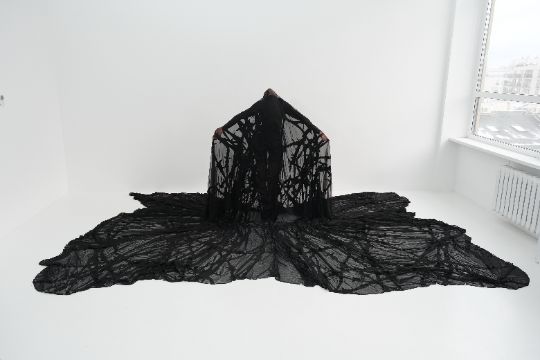
delicate net fabric, 550 × 550 cm, 2022
Captive
550 X 550 сm.
Barbed wire crown with two large glass tears.
Dedicated to Belarusian political prisoners. With this work, I show my solidarity and express admiration for the fortitude and dignity with which people are going through this terrible suffering. To Belarusians, who were captured in prison for their humanity in the struggle for freedom.
oil on canvas, tar, 102 × 81 cm, 2022
Maiming
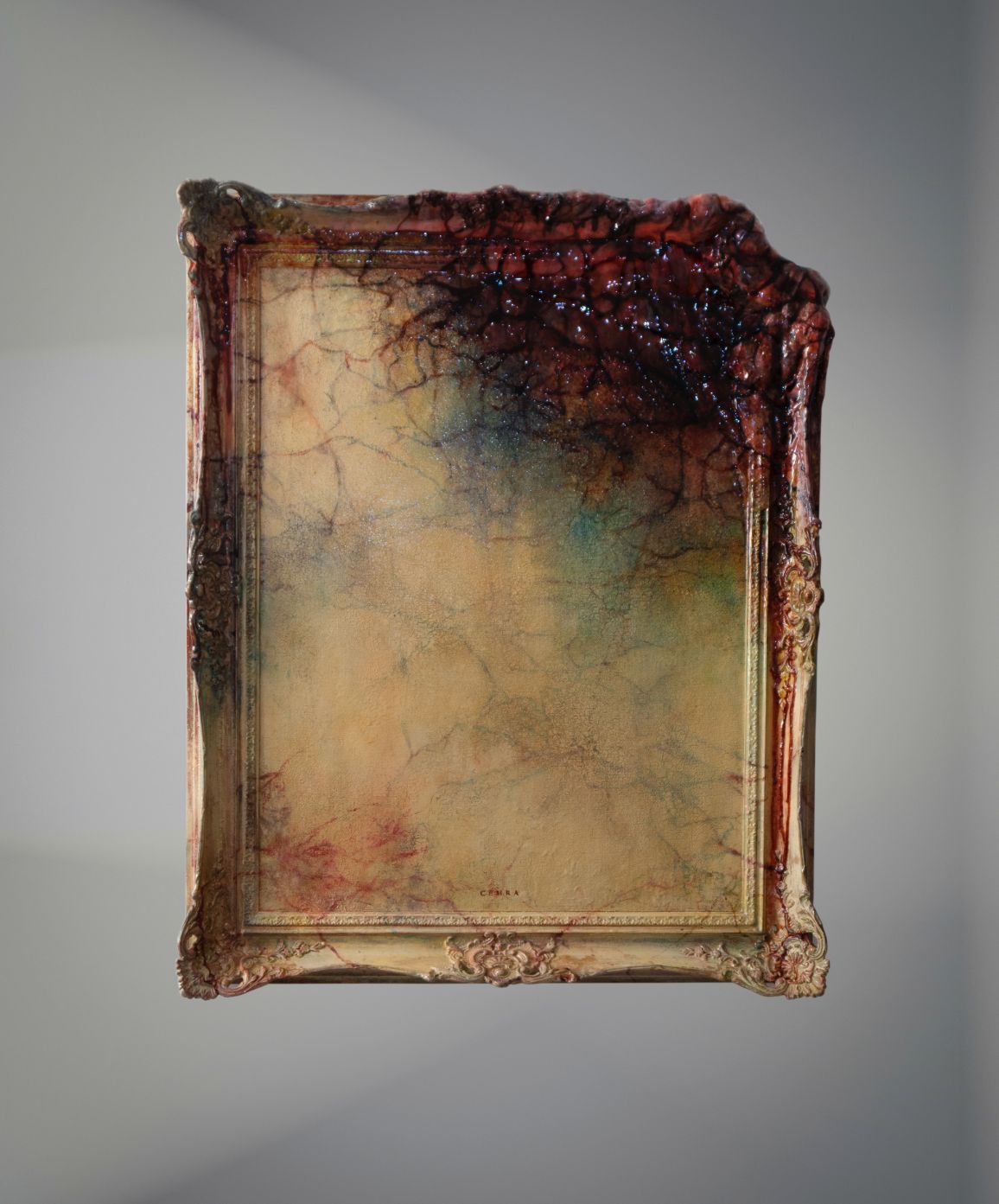
mixed media, 194 × 77 cm, 2023
Alive / Жыве
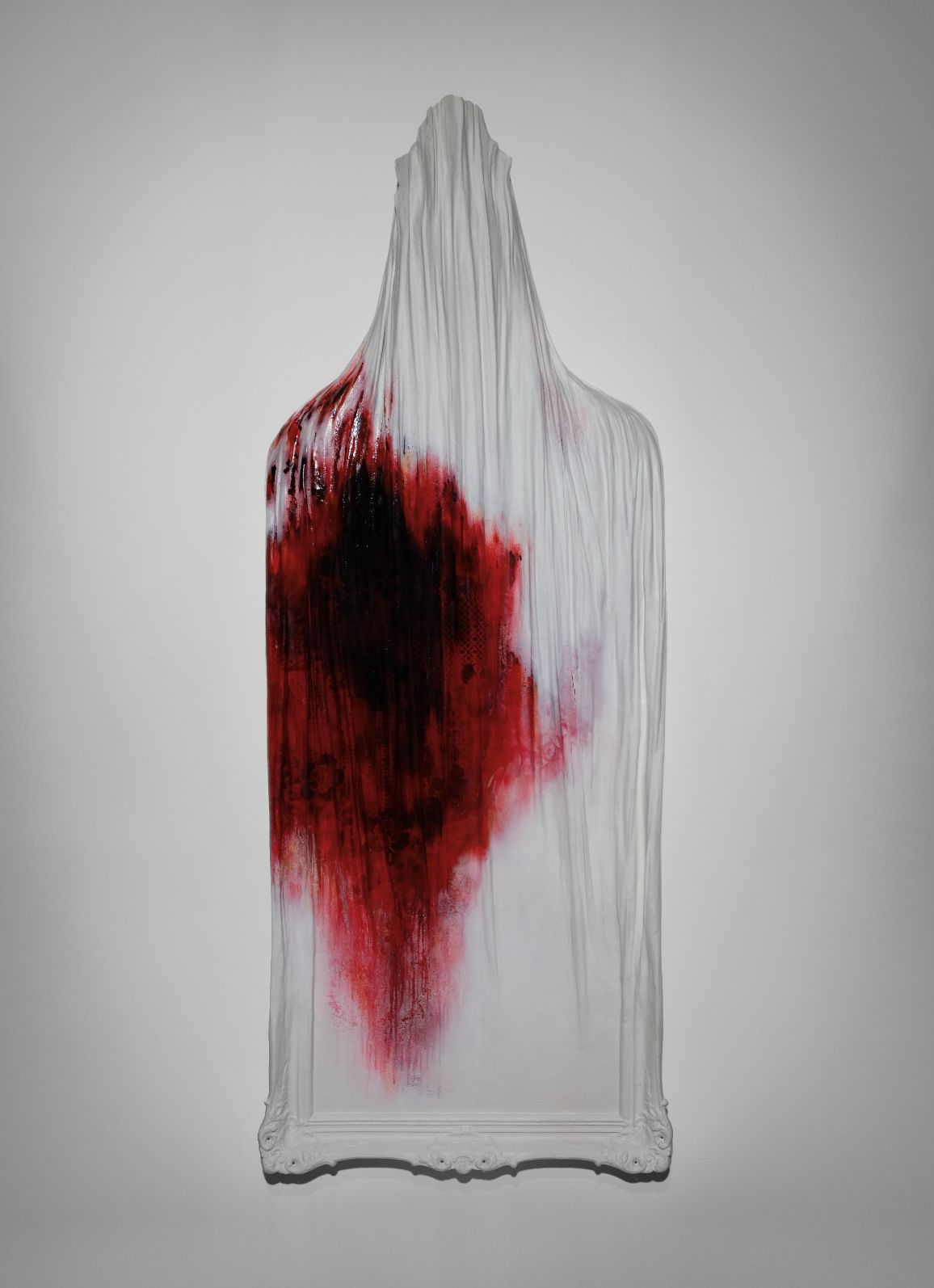

plexiglass mold, oil, resin coating, 85 × 65 cm, 2023
Sores
plaster bandage, oil, 94 × 72 cm, 2023; reworked 2025
PAINting
A year ago, I took a vow of abstinence from alcohol and jewelry — an ascetic gesture made for a wish that has not yet come true. It was a renunciation of the external in order to focus on the internal. For a year I neither drank nor adorned myself. This painting remained the only one without a home after the Lazaret exhibition, and I decided to gift it my jewelry — even my grandmother’s earrings — so that it might become more beautiful, loved, and accepted. Among these ornaments are pieces of Czechoslovak costume jewelry, some more than sixty years old. Produced in the 1950s–1970s, such pieces are increasingly regarded as collectible, as production on this scale and of this quality no longer exists.

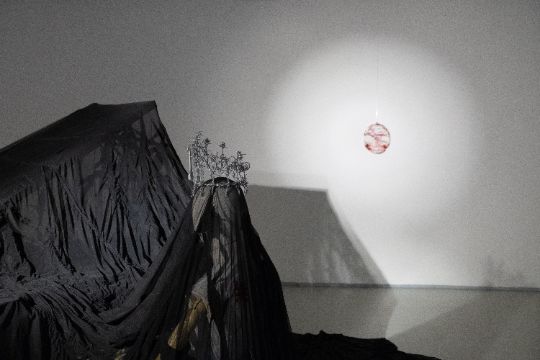
mixed media, 31.5 × 27.5 cm, 2023
Veins of Stone
our blood's coagulability increases.
This reaction is linked to our body's primal response to injury threats, where thicker
blood would help in stopping bleeding.
bandage on oil, 140 × 140 cm, 2022
Sign of pain
Creating this painting required more than 100 packets of bandages, which I rewrapped and saturated with varnish across all layers. In my art, the national symbol breaking through the bandages signifies the resilience of the Belarusian people, acknowledging our collective pain. This work is an homage to our shared struggles, embodying the spirit of resilience and the hope for healing and liberation. The symbol serves not just as a testament to our hardships, but also as a beacon of our enduring strength and unyielding determination. Through my art, I aim to tell our stories, give voice to our experiences, and contribute to our shared narrative of resilience, triumph, and hope.
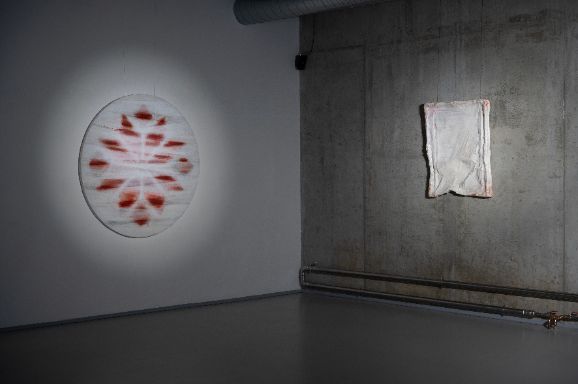
canvas, oil on bandage, 85 × 75 cm, 2022
Victim
In bandages, even if they are dense, there is always a splash of blood. The common theme that connects my works is the entanglement of various traces marked by blood and ruptures of tissue. These materialized wounds are connected to memories of detachment from the home or homeland. Reflecting on the experience of homelessness and forced refuge, my works demonstrate the never-completed, non-linear, and still-bleeding process of healing that transcends the bounds of chronological time.
This artwork has a special story. I started it in Belarus at a moment when I was forced to evacuate urgently due to political repression. Later, while I was in Kyiv, I received the painting and completed it within two months during my stay there.
When the war began, I had to flee once again — I left all my works in the bathroom of a rented apartment and went to Poland. Later, during wartime, I managed to retrieve “The Sacrifice” along with two other paintings — they were sent to me from Kyiv to Poland.
This painting has traveled a long road with me.

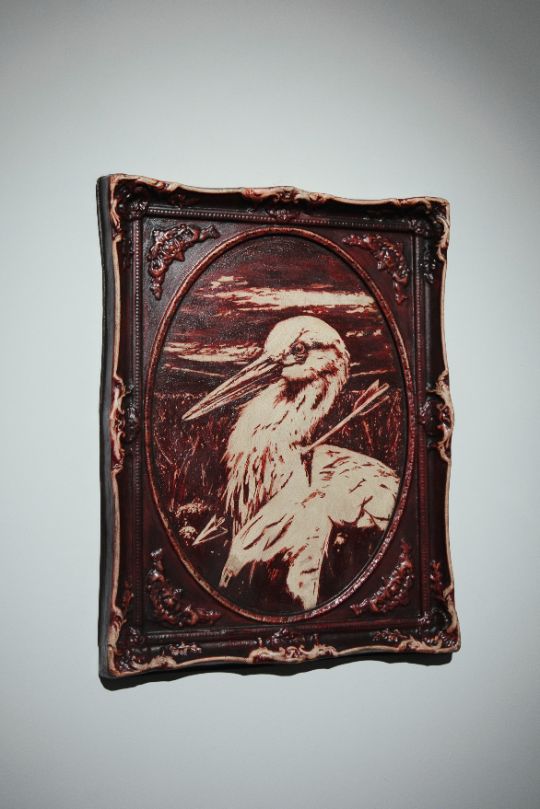
plexiglass mold, tar, oil, 85 × 65 cm, 2022
Under the sky of Belarus
“I see in his gaze a piercing look directed at humanity — a humanity that has failed to learn from the Holocaust. I see in him reproach and sorrow, acceptance and departure, alienation and denial.”
— Written from prison by someone who saw this work at the exhibition.

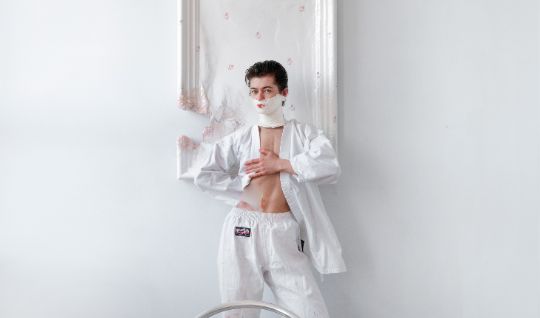
WANT TO SUPPORT MY ART?
Art may break into our lives by chance that is amazing. But without your support, it would happen less and less. Art reflects, as well as shapes culture – both yours and mine! Your support will help art evolve and be created.
Support my Art! Or give support to your favorite artist!

gypsum, canvas, epoxy resin, 80х50 cm, 2020
Rape
Dedicated to the Belarusians who were raped by the government.
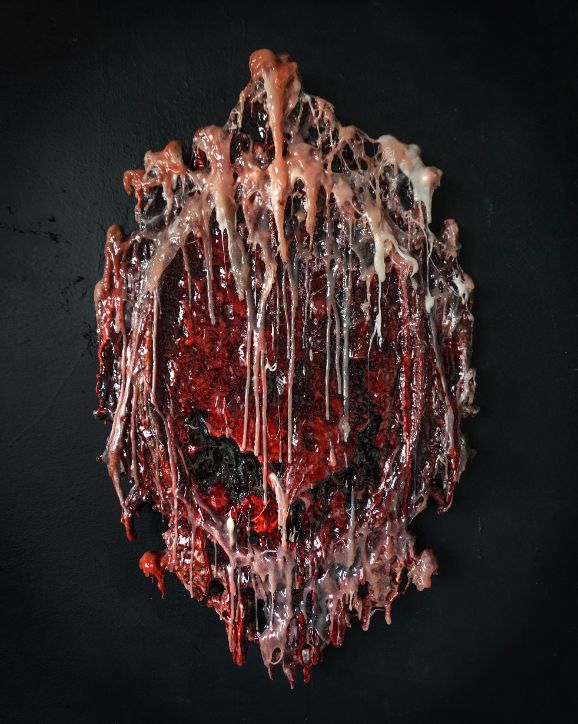
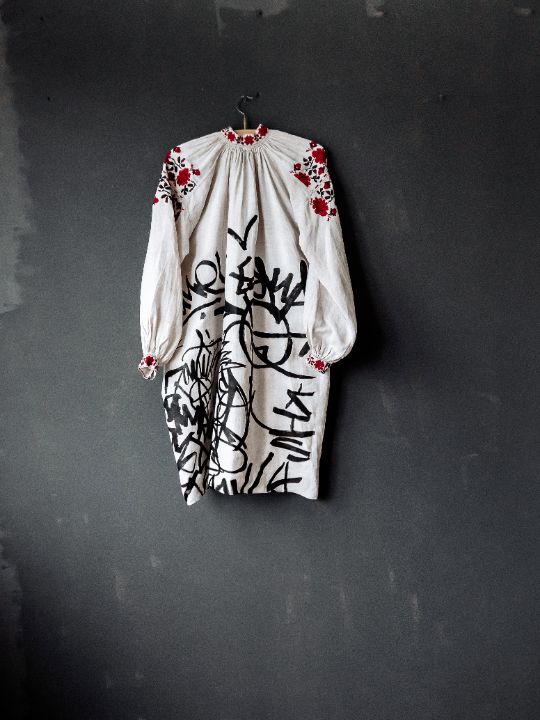
Home-woven fabric, embroidery, acrylic paint, 2019
The Heritage / Spadchina
In pursuit of rampant consumption, we destroy inherited strong houses, throw away solid
furniture and household utensils emptying grandmother's chests; at the same time we strive to surround ourselves with Chinese things replacing valuable items with cheap "run-of-the-mill" goods.
A consumer society is a massive consumption of material goods and the formation of an appropriate system of values and attitudes. Moreover, more than half of the purchases we make are not a vital necessity for us. The society is forced on with the idea that the possibility of acquiring various "convenient and beautiful things" is the norm.
Each person has a great responsibility for the choice that he/she makes, what deeds, things and thoughts he/she fills in his/her life with; what things and deeds he/she values. After all, our daily choice in favour of certain things forms the choice of a society, nation and a generation. Our daily choices are directly related to the preservation of our heritage.
The name of the project is written in Latin letters. Thus, due to a word-play there is the
word "China" in "Spadchina".
Plexiglass, photo: digital printing, 85 × 65 cm, 2019
Plastictheism
Humanity has grown utterly reliant on plastic. The work Plastictheism confronts the folly of our reckless dependence on single-use plastics, which has precipitated a global waste crisis. Through this piece, I seek to draw attention to the environmental consequences of plastic consumption and inadequate recycling—and to urge everyone to take responsibility by eliminating disposable items such as utensils, bags, and bottles from daily life.
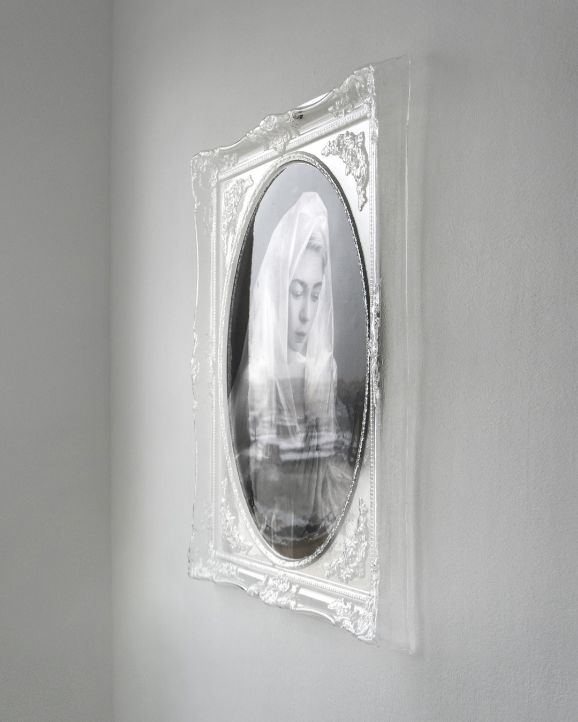

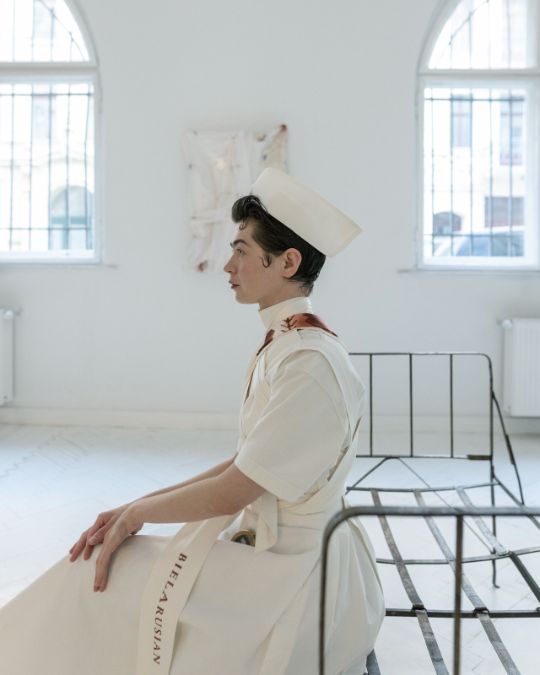
I view a painting as a living body — bearing scars and wounds, feeling, vulnerable, and capable of healing. To me, a painting is a sentient being that can experience pain and carry memory. Working with plaster bandages, resin, oil, and varnish, I form the “epidermis” of the canvas, transforming it into a bearer of human and non-human stories. I invite the viewer to encounter these paintings as living witnesses to struggle and transformation.
I am particularly inspired by Teresa Margolles, whose practice engages social trauma and memory with precision and care. I resonate with that depth and ethic — the drive to endow a work with empathy and significance while remaining true to my own path and cultural context, expanding the boundaries of painting as a form of feeling.
My work has been supported by several residencies and grants, including the Artist-in-Residence program of Kulturvermittlung Steiermark and the City of Graz, Austria (2025); the “Adradzhenne” National Revival Scholarship from the Representation for National Revival of Belarus (2024); the ArtPower Belarus Grant awarded by the Belarusian Council for Culture and the Danish Cultural Institute with support from the European Union (2023); and the Dukley European Art Community Residency in Budva, Montenegro (2020).
Solo exhibitions
2025 – FRAGILE, MAD Gallery, Poznań, Poland
2023 – LAZARET, Beseder Gallery, Prague, Czech Republic
2023 – LAZARET, Museum of Free Belarus, Warsaw, Poland
2021 – AESTHETIC PAIN, A&V Art Gallery, Minsk, Belarus
2020 – CEMRA, Art-Belarus Gallery, Minsk, Belarus
Group exhibitions
2025 – The Arrows of Resilience: Reimagining Saint Sebastian, MAD Art Gallery, Warsaw, Poland
2023 – Charity Auction for the Humanosh Foundation, Exhibition of works by Belarusian, Ukrainian, and Polish artists, Piękna Gallery, Warsaw, Poland
2023 – Where am I. Exhibition of contemporary Belarusian art, Montenegro European Art Community Gallery, Budva, Montenegro
2023 – Who Owns the Land: Art as agent of expression conflict, statelessness, diaspora, coloniality, THE PINNA Gallery, exhibition online, London, England
2021 – The Autumn Salon, National gallery Palace of Arts, Minsk, Belarus
2020 – Art-Minsk the international art festival, National gallery Palace of Arts, Minsk, Belarus
2019 – The Autumn Salon, National gallery Palace of Arts, Minsk, Belarus
2019 – Triennial of Young Artists, National gallery Palace of Arts, Minsk, Belarus
cemraart@gmail.com
